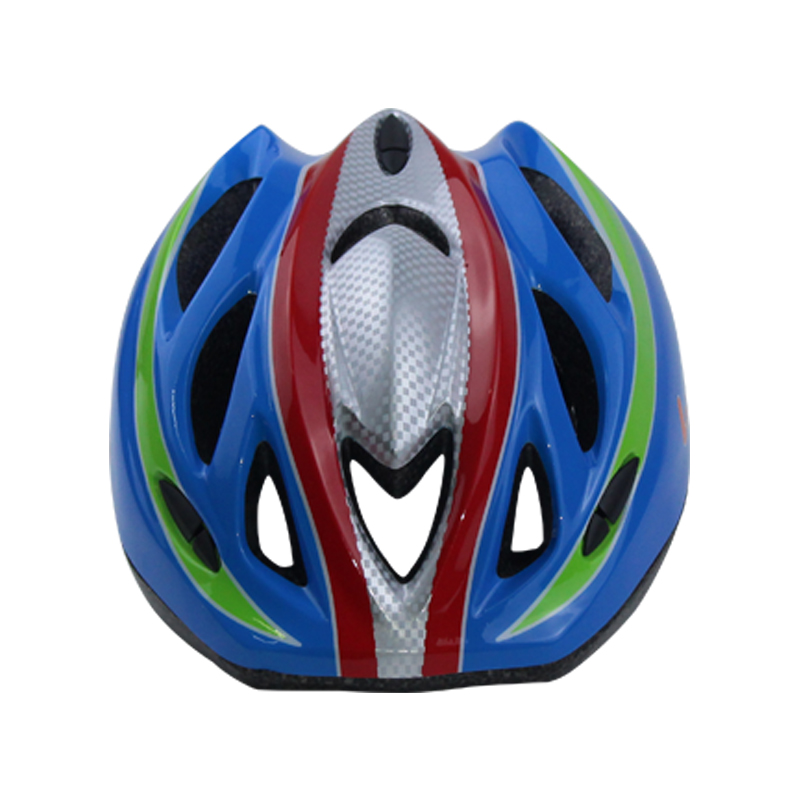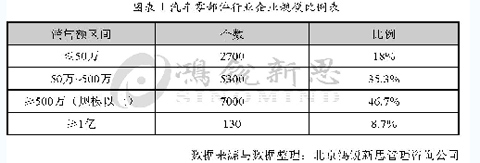Needless to say, the secret dilemma of secret small and medium-sized parts enterprises
With the development of China's auto industry, the scale of the auto parts industry is constantly expanding. However, the expansion of the scale does not represent an increase in the strength of the industry. According to data from Beijing Hong Rui Xinsi Management Consulting Co., Ltd., China currently has a total of more than 15,000 automobile parts and components companies. The specific scale and number of enterprises are as follows:
As can be seen from the above chart, less than half of the total number of parts and components enterprises account for more than the total number, and only a handful of large-scale parts and components companies can truly exceed 100 million yuan. Most of the parts and components companies are small and medium enterprises. In fact, at present, China's spare parts industry has a weaker industry strength and a smaller enterprise scale. The prospects for the development of the entire parts and components industry are not optimistic. Especially for those small and medium-sized parts and components enterprises, the living environment is even worse. According to Cao Yanchun, a research consultant for Hongli Synopsys’ automotive industry, the factors that have caused the deterioration of its living environment can be analyzed in terms of both objective and objective: objective factors include the government, upstream raw material suppliers, and downstream OEMs. Parts companies also have their own To shirk responsibility. Loss of government policy First analyze the government's factors. The main responsibility of the government is to address the lack of protection policies for SMEs and the inequality of supportive policies. The lack of protective policies We can face the most important problem facing SMEs - financing difficulties. Since information asymmetry banks are reluctant to lend to small and medium-sized enterprises, small and medium-sized farmers are reluctant to lend to state-owned commercial banks, which directly leads to difficulties in financing and loans for SMEs. However, the respective concerns of banks and SMEs could have been solved by the government. The government can give support to the enterprises that provide loans for SMEs, provide loan guarantees for some SMEs with special competitiveness, etc., but the government It shows too much indifference here. The so-called inequality of supportive policies means that local governments are equal to large and medium-sized enterprises in terms of collecting taxes and fees. However, when small and medium-sized enterprises need government support due to funds, technology and other issues, the government has few echoes. The government has just given supportive policies to those big taxpayers. For example, a hundred small and medium-sized enterprises in a certain place have a tax of 2 billion a year for the government, and a large enterprise has a tax of 500 million a year. Then the government will provide various preferential policies to the large-scale enterprises, including taxes. Preferential and public resource concessions are sold, and the voices of these 100 SMEs tend to respond negatively and lagging behind. Extrusion of raw material suppliers Then analyze the upstream supplier's factors. The main responsibility of upstream suppliers is to use their own monopoly or oligarchic status to squeeze parts and components companies. For parts and components companies, especially the second and third-tier component manufacturers (these are mainly small and medium-sized enterprises), their upstream suppliers are generally large industrial raw material companies. For example, producers of steel and non-ferrous metals have negligible bargaining power and bargaining power compared to their counterparts. In the face of its price increase and lack of timely supply, parts and components companies have no alternative. Downstream OEMs are strong Analyzing the downstream OEMs, we can see that their main responsibilities are in the following two points: 1. Utilizing their strong position to reduce the profitability of spare parts companies for their own interests. For example, when sales decline in companies need to reduce costs, the first major measure adopted by OEMs is to reduce the purchase price of parts and components. 2. Many SMEs are responsible for the burden on the OEM. Faced with the increase in cost and sales volume in the near-term period, the OEMs are struggling to reduce costs, which is mainly achieved by reducing internal expenditures, layoffs, and lowering raw material purchase prices. And low-cost acquisitions will be the most effective way to control costs. In the face of a strong OEM, most parts and components companies do not have bargaining power. As a result, parts and components manufacturers have been stricken by the double pressure of the upstream and downstream, and the profit space has been compressed indefinitely. In addition, SMEs also bear a lot of responsibility that is unnecessary or should not be assumed. According to the company's understanding, many OEMs now require the establishment of third-party inventory around the parts companies. The reason for the OEM is to reduce its warehouse occupancy and management costs and to respond appropriately to market changes. Most of these third-party inventories are inextricably linked to the OEM. This is the inventory organization that is also very chaotic. It is not even possible to provide inventory for companies that store parts in their warehouses. The irresponsibility of the OEM is also reflected in frequent changes in orders. Host plants can change the production orders that have already been released due to changes in their own production plans and market conditions. Some parts companies even responded to the 30 orders they had received in one month, and there are as many as tens of each. Products and changes include various items such as delivery time, delivery quantity, and product variety. This undoubtedly aggravated the production costs of parts and components companies and affected their delivery speed and quality. Frequent change orders revealed that the OEM's production management is not in place, but this responsibility has always been borne by the parts companies. The reason for the parts companies themselves Of course, the emergence of any problem cannot be attributed only to external factors. The survival dilemma of small and medium-sized component companies also has its own reasons. This is mainly reflected in three aspects: unstable quality, lack of timely delivery, and backward technology. Some second- and third-tier component suppliers found themselves struggling to meet the quality and stability of the mainframe plant and timely delivery of the product. This is evident in some domestic OEMs that have a faster pace of localization. For example, FAW-Volkswagen Sagittarius “fire-extinguished†recently was caused by the quality of electrical harnesses; Fox recalled the quality problems caused by the insulation material of fuel pump wires; while the Beijing Hyundai Elantra and Sonata cars are due to internal parts of some vehicle ignition switches. Inconsistent size. The backwardness of technology is mainly reflected in the backwardness in the supply capacity of some high-tech parts. China's spare parts manufacturers cannot guarantee the supply of quality and quantity such as galvanized steel sheets, high-tensile steel sheets, surface-treated steel sheets, plastic raw materials, alloy materials, spring steels, paints and other raw materials with certain technical contents. Imported abroad. The product quality, supply capacity, and technical level of domestic small and medium-sized component companies have seriously affected their market competitiveness. After a comprehensive analysis of the industry chain of small and medium-sized component companies, we found that the deterioration of their living environment is caused by both internal and external causes, and external factors dominate this position. The healthy development of small and medium-sized component enterprises requires a more relaxed environment. Such an environment needs the government to take the lead, raw material suppliers and OEMs actively cooperate with each other, and the spare parts companies themselves work hard to jointly create. |
We believe that children should be encouraged to participate in organized sports and to participate in a family and/or community sport. Youth athletes should be taught the fundamentals of safe, fun and fair competition and be given an opportunity to be supported and connect with the rest of their family through the sport they love. So Bike Helmet is also very important for us to do such job.
The vents help and speed cooling down of the head. The more the vents are set, the greater the reduction in sweat, but it also makes the helmet hot. Since the vents allow air to blow in to the outer layer of the helmet and the inner frame keeping in the cool air is necessary for a durable helmet.

Kid Helmet,Children Cycling Helmets,Cute Children Cycling Helmet,Children Bike Helmets
Dongguan Yoloon Sports Goods Co.,LtD , https://www.dgyoloonprotection.com
